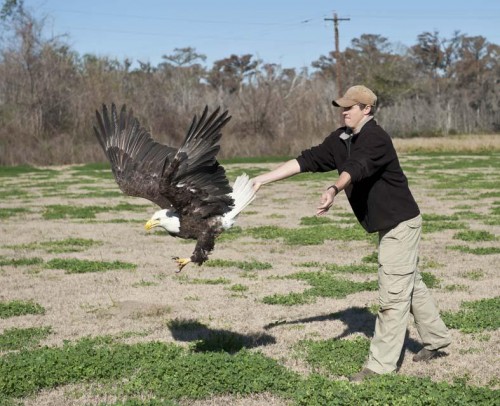
Russell Trosclair Sr.
February 25, 2012
CIS patient promotes education as prevention
February 28, 2012Louisiana State University graduate student Nick Smith has begun a study that will provide answers to questions about the Louisiana bald eagle regarding migration routes and other significant variables.
Smith intends to track the migration patterns of 10 birds over the course of two summers using a GPS tracking system attached to the back of the bird. Since starting in January, he has managed to capture three birds and attach the GPS system that will provide the information he needs concerning the decreasing bald eagle population during summer months.
“The main objective is to find out where Louisiana bald eagles are going during mid-summer,” Smith said. “Around June, July and August a lot of birds aren’t seen and it is presumed that they are heading north.”
Though his research focuses mostly on the birds’ final destination, he also intends to study the migration route, considering its consistency and anything that may stand as a hazard to the well being of the animals. In addition, Smith intends to gather state surveys from 1984 to 2007 to study the birds’ nesting habits and the population’s growth rate.
“By figuring out where the birds go during migration, we can figure if there are any resources or anything causing a threat or decrease in the population,” Smith said.
The population of bald eagles in the United States has grown significantly over recent years, and in 2007 the group was taken off of the endangered species list. According to Smith, Louisiana once held 2nd place in the highest concentration of bald eagles.
Within the state, most birds are found in the southeast or south-central area; the highest concentration is seen within an 80-mile radius surrounding the Mandalay area. For this reason, Smith stays at the Mandalay National Wildlife Refuge area for trapping, living in a type of dormitory provided by the U.S. Fish and Wildlife Service and still commuting back to Baton Rouge for class.
Trapping the birds has been a slow process for Smith thus far. The first day he was able to capture two birds but has only caught one since, two adults and one sub-adult. Nutria rat among other things has been used as bait. Once the eagle is in position, Smith uses a large net launched by three rocket launchers to capture the bird, making it easy to attach the GPS system by way of harness.
“We put a band on made of Teflon ribbon and the GPS sits on the back,” said Smith. “We use a falconer’s hood during the process, covering their eyes and that seems to calm the bird down. In fact, the first bird might have been asleep by the end of it.”
Smith is eager to find results and said he has no idea what he may find.
“I’m really going in blind,” Smith said. “Some expect that they are doing the same thing as the Florida population, flying as far north as Canada. But this population doesn’t show all of the same characteristics so they may be going more laterally.”
Smith has a special interest in avian and other forms of wildlife. Originally from Minnesota, he graduated from South Dakota State University where he studied wildlife and fisheries studies. He spent a few years doing plover research for Northern Prairie Wildlife Research Center and has done multi-species surveys in Iowa for the Department of Natural Resources. Smith applied to the masters program at LSU specifically for the project.
“I knew the professor and when I saw this project I was excited to take it on,” Smith said. “I intend to spend two summers gathering data and the third year writing my thesis and preparing published works.”
Nick Smith, a graduate student at Louisiana State University, releases a bald eagle into the wild. Smith has trapped three eagles, which he outfitted with GPS tracking systems to monitor migratory patterns. COURTESY PHOTO








